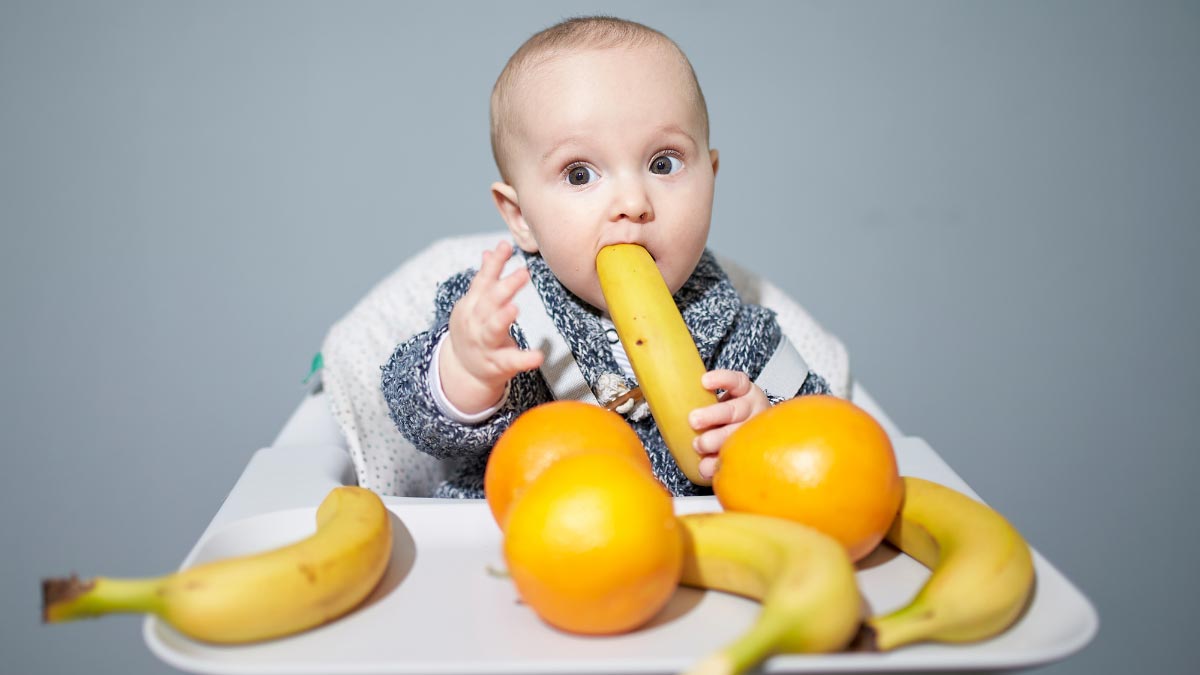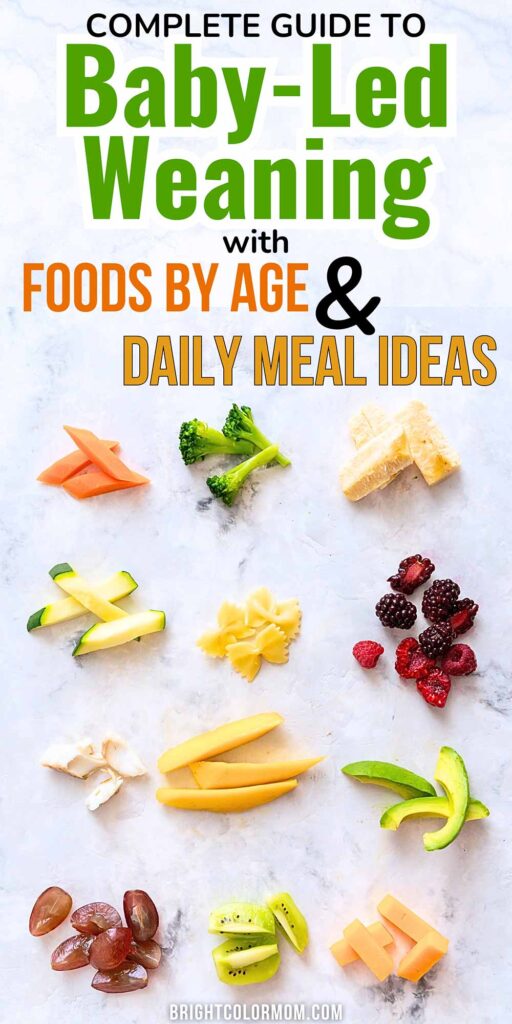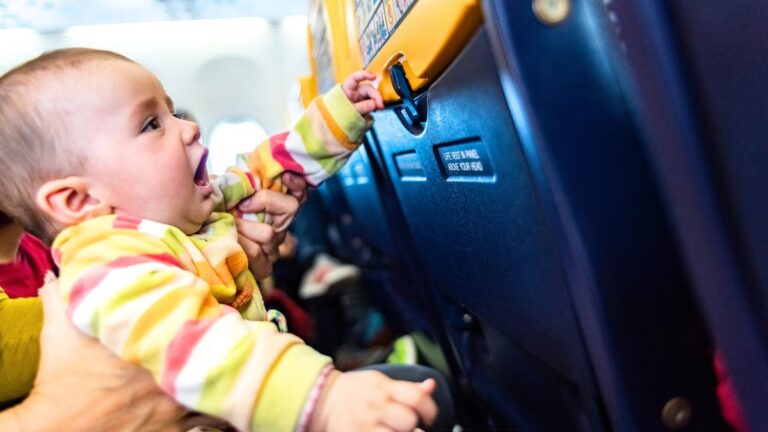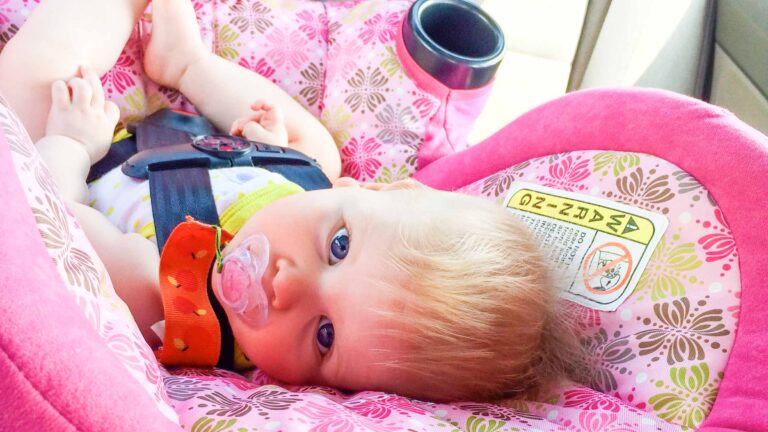We’re about to embark on a messy, hilarious, and ultimately rewarding journey: introducing your baby to the wonderful world of solid food. Enter Baby-Led Weaning (BLW), the feeding method taking the modern parenting scene by storm. This article covers all aspects of baby-led weaning, so if you need specific info, choose a section from the list below.
This post may contain affiliate links. If you make a purchase after clicking one, I may receive a small commission at no cost to you.
What Baby-Led Weaning Is
Think of BLW as ditching the spoon-feeding routine and letting your little one take the reins. It’s all about self-discovery through exploration. Just picture tiny fingers picking up chunks of healthy, yummy goodness! This isn’t just about filling their bellies; it’s a milestone moment for developing those fine motor skills. Plus, they get to choose what and how much they eat from portions of the same family-friendly foods you’re enjoying at mealtimes.
BLW gained serious traction around 2008, thanks to Gill Rapley, a former public health nurse in the UK. It resonates with parents seeking a more laid-back, baby-led approach to mealtimes. Plus, it aligns perfectly with the Montessori philosophy of fostering independence in little ones.
Why BLW Might Be a Good Fit
Before you envision a tiny tornado flinging pureed peas across the kitchen, let’s dig deeper into why BLW might be the perfect fit for your family. We’re talking about benefits like building healthy eating habits, mastering those all-important motor skills, and creating a positive mealtime environment for everyone involved (including you, the slightly frazzled parent).
Benefits of BLW
We know baby-led weaning is all about letting your baby take charge of their food adventure, but what are the actual benefits for your little munchkin (and maybe even you)? Here’s the lowdown.
Motor Skill Development
Forget the spoon – BLW is like boot camp for those developing motor skills. Picking up those teeny finger foods hones their hand-eye coordination, strengthens those little mouth muscles (oral motor development!), and teaches them the art of the perfect grasp.
Self-Regulation
BLW isn’t just about your baby shoving food in their face (although that might be their initial strategy). It’s about them learning to recognize their hunger cues. They get to explore textures, take breaks when they’re full, and basically become the boss of their own belly. This self-regulation translates into healthy eating habits down the road – win!
Food is Fun, Not a Fight
Picture this: your baby happily gumming on a sweet potato wedge, a genuine look of enjoyment on their face. That’s the magic of BLW. Letting them explore different foods and textures at their own pace helps them develop a positive association with mealtimes. No more forced spoon-feeding battles, just pure food exploration joy.
Less Picky
There’s some research suggesting babies who start solids with BLW might be less likely to be overweight or picky eaters later on. Now, that’s something to celebrate.
Money Saved
Can you imagine only feeding your baby bites of your meals and never buying jars of baby food? You’ll be able to pay for their college education with those savings!
When to Start BLW
So you’re on board with the baby-led weaning train – awesome! But before you unleash your baby on a buffet of broccoli florets, let’s chat about when and how to get this party started safely and successfully.
Every baby develops at their own pace, but there are some general milestones to look for before diving into BLW. Here are the key signs your tiny food explorer is ready to take charge.
- Head Control: They’ve got good head and neck control, meaning they can hold their head up nice and strong.
- Sitting Up: They can sit with minimal support, which is crucial for safe self-feeding in that highchair.
- Curious Tasting: They’re reaching for and mouthing objects with gusto – a natural first step in their food exploration journey.
- Pushing Food Back: If you spoon-feed a bit of applesauce or puree, they should push it to the back of their mouth, not out to dribble down their chin.
Safety First
Now that you’ve established your baby’s a BLW candidate, let’s set them up for success (and minimize the emergency clean-up operations). Here are some key things to remember.
Highchair
Make sure that the highchair is a fortress of safety. Proper positioning is key, with a stable chair and a harness to keep your little adventurer secure.
Food Fit for Tiny Fingers
Think finger foods! Cut them into safe shapes and textures – soft and easy to gum is the name of the game. Think steamed veggies, ripe fruits, and soft cheese cubes.
Slow and Steady
Don’t overwhelm your baby with a ten-course tasting menu. Start slow with one food at a time, once a day, and gradually introduce more options and daily meals as they get comfortable.
Ditch the Dishes (For Now)
Plates and bowls are just begging to be thrown on the floor. Skip them for now and let your baby explore food right on the highchair tray (easier clean-up, trust me).
Rainbow Foods
Variety is the spice of life, even for tiny taste buds! Offer a range of colors and textures to develop their palate and keep things interesting.
Stay Close
Remember, supervision is key. Always eat meals with your baby and constantly monitor them during feeding times to prevent choking hazards. BLW is about exploration, but safety always comes first.
Watch BLW in Action
I highly recommend watching the below video of a baby eating various foods during her first week of baby-led weaning. It’s so cool to see how quickly she develops the skills needed to pick up food and bring it to her mouth! You’ll see some gagging, too, which is completely normal and to be expected.
Great Baby Led Weaning First Foods
Here’s a handy guide to introduce a variety of finger foods as your baby graduates through their BLW journey! This is just a general guideline, and you can introduce foods at your baby’s pace. Remember, always cut or modify these foods into safe shapes and sizes to prevent choking.
Beginners (Around 6 Months Old)
These soft, easy-to-gum options are perfect for first-time eaters to explore textures and flavors.
Fruits
- Ripe bananas (peeled and cut into thick rounds)
- Steamed or roasted pear wedges (seeds and skin removed)
- Well-cooked and mashed mango chunks
- Very ripe avocado slices
Vegetables
- Steamed broccoli florets (cut into small florets)
- Well-cooked sweet potato cubes (skin removed)
- Steamed green bean pieces (cut into short lengths)
- Roasted cauliflower florets (cut into small florets)
Others
- Well-cooked and crumbled scrambled eggs (skip the salt)
- Soft tofu cubes (steam or pan-fry until slightly firm)
- Well-mashed ripe peaches
Confident Babies (Around 8 Months Old)
As your baby’s motor skills develop, you can introduce slightly more challenging textures and shapes.
Fruits
- Soft berries (cut in half)
- Sliced kiwi (peeled and sliced)
- Steamed apple slices (core removed)
- Cantaloupe wedges (cut into finger-length strips)
Vegetables
- Steamed carrot sticks (cut into thin sticks)
- Cherry tomatoes (quartered lengthwise)
- Roasted red bell pepper strips (cut into thin strips)
- Steamed asparagus tips (cut into bite-sized pieces)
Others
- Small cooked pasta shapes (cooked until very soft)
- Soft cheese cubes (like cheddar or mozzarella)
- Small cooked lentil or bean pieces (well-cooked and softened)
- Bite-sized pieces of well-cooked, shredded chicken or fish (deboned and flaked)
Experienced Eaters (Around 12 Months Old)
For these little foodies, the options can expand even further, incorporating a wider variety of textures and flavors.
Fruits
- Grapes (cut in half lengthwise)
- Dried fruit (chopped into very small pieces) – monitor closely for choking
- Diced mango or pineapple
- Sliced melon (honeydew, watermelon)
Vegetables
- Raw cucumber sticks (peeled and cut into thin sticks)
- Cherry tomatoes (whole)
- Baby corn cobs (cooked until tender)
- Shredded raw broccoli or cauliflower florets
Others
- Pancakes or muffins torn into small pieces
- Small cooked whole-wheat crackers
- Bite-sized pieces of hard-boiled egg yolk
- Small cooked meatball pieces (cooked thoroughly and cut into small pieces)
Family Meals
Don’t reinvent the wheel! Many family meals can be easily adapted for BLW. Steamed veggies, tiny bites of cubed cooked chicken or fish (remove any bones!), scrambled eggs (hold the salt) – the possibilities are endless. Just remember to remove skins from fruits and vegetables and cut everything into small, safe pieces.
Sample BLW Meals
Here’s a sneak peek at a sample BLW meal plan for a 1-year-old to give you some ideas.
Day 1
- Breakfast: Mashed banana with a sprinkle of cinnamon on a highchair tray.
- Lunch: Steamed broccoli florets with a dollop of hummus for dipping.
- Dinner: Baked salmon flakes with mashed sweet potato.
Day 2
- Breakfast: Scrambled eggs cut into strips with a side of steamed avocado.
- Lunch: Well-cooked pasta spirals with a simple tomato sauce.
- Dinner: Roasted cauliflower florets with a sprinkle of grated cheese.
Day 3
- Breakfast: Soft oatmeal with diced blueberries.
- Lunch: Sliced ripe pear with a sprinkle of chia seeds.
- Dinner: Steamed green beans with soft chicken chunks.
Troubleshooting Common Concerns
There can be some bumps along the food adventure road. Here’s how to navigate some common concerns.
Choking Hazards
I get it – choking is a top worry for any parent, and watching them gag on solid foods can be scary. But relax! The gag reflex is your baby’s built-in safety mechanism, preventing them from swallowing anything too big. Also, gagging is different from choking – because the latter is usually silent. BLW, with its focus on safe-shaped and textured foods, actually helps them learn to explore food safely.
This study published by the AAP states that babies using baby-led weaning don’t choke any more often than babies on pureed foods! Remember, constant supervision during mealtimes is key. Taking an infant CPR class is also a great idea for added peace of mind. Read more from the CDC about avoiding choking while eating.
Allergy Alert
Introducing new foods comes with the possibility of allergic reactions. Watch out for symptoms like hives, swelling, or trouble breathing. But guess what? Allergies can happen with pureed foods too! BLW doesn’t increase the risk, it just means you might spot a reaction sooner.
Keeping it Clean
Listen, BLW is messy. Embrace it. It’s a sign your little one is exploring with gusto! Here’s how to minimize the mess: a washable mat under the highchair is your new best friend. A bib with a pocket will catch rogue food missiles.
Must-Have Nutrients
Iron is a common concern with BLW. Here’s the thing: you can totally incorporate iron-rich foods! Think well-cooked, mashed lentils or fortified cereals. A balanced diet is key, so offer a variety of foods from all food groups. Regular pediatrician checkups are also crucial to monitor growth and development.
Picky Eating
Exposure, exposure, exposure! That’s the BLW way of dealing with picky eaters. The more your baby sees and touches new foods, the more likely they are to try them. Be patient! Some babies take longer to warm up to new tastes and textures. Keep offering a variety and trust the process.
How to BLW While Traveling
Sometimes, a mess-free meal is a must. BLW on the go can be a juggle, so don’t be afraid to combine spoon-feeding with some travel-friendly finger foods. Think steamed veggie sticks, puffs, or even mashed banana on a spoon. Pouch foods can also be a lifesaver in a pinch. The goal is to keep offering a variety of textures and flavors, even if it’s not a full-blown BLW extravaganza.
BLW vs. Traditional Spoon-Feeding
Let’s talk about the OG method of introducing solids – spoon-feeding. Mashed fruits and veggies, airplane spoon battles – it’s a familiar routine for many parents. Both BLW and spoon-feeding can be successful ways to introduce solids, but the core difference boils down to control. In BLW, your baby calls the shots (on what and how much they eat), while spoon-feeding puts you in charge.
There’s a whole spectrum of parental philosophies when it comes to feeding. Some parents might feel more comfortable with the structure of spoon-feeding, while others love the autonomy BLW fosters. The good news? There’s no single “right” way! The best approach depends on your personal preferences, your baby’s temperament, and their developmental cues.
Communication is Key
Here’s a crucial point, especially if you have multiple caregivers involved: open communication is important! If you choose BLW, make sure everyone who feeds your baby (think grandparents, daycare providers) is on board and understands the approach. This ensures consistency and a smooth transition for your little one.
Essential BLW Tips
You’re officially prepped to rock the BLW world! But before you dive in, here are some extra tips to make mealtimes a breeze.
Dress Down
Forget the fancy outfits – mealtimes are for exploration, not fashion shows. Embrace the mess and dress your baby in just a diaper and a bib with a pocket. Either way, laundry is a small price to pay for a happy, independent eater.
Get a Grip
Avocado slices a bit too slippery for those tiny fingers? No problem! Stick the avocado wedge onto a larger, easier-to-grab piece of toast or coat it in fine cracker crumbs. Instant finger food win!
Make it Positive
Set the mood for mealtime fun! Put on some upbeat tunes, chat with your baby, and make it a positive experience. Remember, you’re laying the foundation for healthy eating habits, so model those good choices by eating together as a family.
Don’t Apply Pressure
This isn’t a food fight – it’s a culinary adventure! Don’t pressure your baby to eat everything offered. Feeling overwhelmed? BLW and spoon-feeding can totally co-exist, so don’t be afraid to mix things up!
Follow Their Lead
Your baby is the boss of their belly! Learn their hunger and fullness cues. Are they rooting and reaching? Time to eat! Fussing and pushing food away? Mealtime is over. Trust their instincts and let them determine how much they eat.
Find a BLW Buddy
The internet is a treasure trove of BLW resources! Join online support groups, check out lactation consultant websites, or find a BLW-friendly pediatrician for extra guidance. You’ve got this!
BLW FAQs
You’ve got a good grasp of baby-led weaning – but you might still have some questions. No worries, I’ve got you covered!
Is BLW safe for every baby?
BLW is generally safe for most healthy babies, but it’s always a good idea to chat with your pediatrician before diving in. They can offer personalized advice based on your baby’s unique needs, especially if they have allergies, developmental delays, or any medical conditions like cleft lip or tongue tie that might make self-feeding challenging or impossible.
Should my baby have teeth before starting BLW?
While teeth aren’t necessary for your baby to mash up soft foods with their gums, teeth (and teething) are a great sign they’re ready to start!
What foods are most likely to cause choking? I want to avoid them.
While BLW promotes safe exploration, there are a few things to keep on your radar. Here are some common choking hazards to postpone introducing until your baby is a bit older and their chewing skills are more developed.
- Round, firm foods: Whole grapes, cherry tomatoes, and hard nuts are a no-go for now. Cut them into smaller, safer shapes.
- Hot dogs: These can be a choking hazard because of their shape and texture. Skip them until your baby is a pro at chewing.
- Hard, raw vegetables: Think raw carrots, celery sticks, and whole corn kernels. Steam or roast them until soft before offering.
- Sticky foods: Whole peanut butter globs and chunks of meat can be tricky for little mouths to manage. Opt for thinner consistencies or cut things into smaller pieces.
My baby won’t feed themselves anything. What do I do?
Don’t stress! Some babies take a little longer to warm up to the idea of self-feeding. Here are some tips to encourage exploration.
- Let Them Lead with Their Hands: Start by letting your baby explore the food with their hands first. This helps them get familiar with the texture and shape before putting it in their mouth.
- Be a Show-Off (In a Good Way): Demonstrate how to use the food yourself. Take a bite, show them how you gum it, and make it look like fun! Monkey see, monkey do (hopefully).
- Patience is a Virtue: Learning a new skill takes time. Be patient, keep offering a variety of safe finger foods even if they’re not taking bites, and trust that your baby will eventually get the hang of it.
My baby will only play with food, not eat it.
Don’t stress if your baby spends more time flinging their food than actually eating it. This sensory experience is crucial for their development and helps them become less picky eaters later on. Let them squish, gum, and explore their food with their hands and mouths – it’s all part of the learning process!
How long should a meal last for BLW?
There’s no magic number when it comes to BLW mealtimes. Your baby is the boss! Let them take the lead and stop feeding when they lose interest or show signs of fullness. This might be after a few bites, or it could be a full-on food exploration extravaganza.
Is there scientific evidence to back up baby-led-weaning?
You bet there is! A study published in the BMJ Open found that babies who practiced BLW had similar energy intakes as spoon-fed babies and were more likely to eat with their families at mealtimes. This can be a great way to foster healthy eating habits from the start.
Can I stop giving milk once my baby is eating solids?
Breast milk or formula remains your baby’s primary source of nutrition during the first year. Baby-led weaning is meant to complement their milk intake, not replace it. Continue offering milk feeds as usual (before solids) and let your baby explore other foods at their own pace.
Continue Your Research
You’ve made it to the end of BLW Boot Camp – congratulations! Sure, there will be messes (lots of glorious, messy exploration!), but the rewards are endless. You’ll be amazed at how quickly your little one develops their motor skills and independence. Plus, watching them explore new flavors and textures can be a truly enriching experience for both of you.
Ready to dive deeper into the world of BLW? Here are some awesome resources to get you started.
- Solid Starts: This website is a treasure trove of information on BLW, with tons of safe food ideas and guidance.
- Katie Ferraro: A trusted source for baby-led weaning, Katie has video courses, food lists, and meal plans ready to go.
So there you have it! Remember, the most important thing is to have fun, embrace the mess (it’s a badge of honor!), and trust your amazing little explorer to navigate their food adventure at their own pace. Happy feeding!








